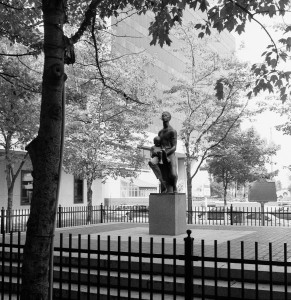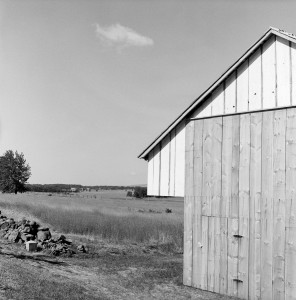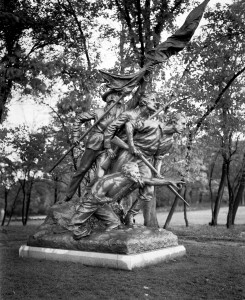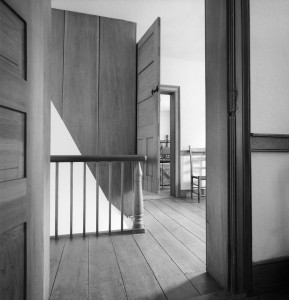Unsung Heroes: History in the Making
by Alan Trachtenberg
Neil Gray, Jr. Professor Emeritus of English & American Studies, Yale University
William Earle Williams defines his subject in this remarkable body of work as “historical places in the New World from the Caribbean to North America where Americans black and white determined the meaning of freedom.” Like his pictures, Williams’ words get right to the point, succinct, definitive, and quietly reverberating: “A Stirring Song Sung Heroic.” What we have are pictures of places that seem quotidian, ordinary, unmarked by monuments, what in “An Ordinary Evening in New Haven” the poet Wallace Stevens calls “the vulgate of experience,” “the eye’s plain version.” Yet, as in the poem, things happen there that alter these places, happened and then forgotten, erased from the site, made invisible yet present enough as recoverable residue, visible to the knowing and imaginative eye. Stevens gives all power to imagination; seeking the real, “the poem of pure reality,” he finds the sun as that which is what it seems; seeing and being as one.
So it is with Williams, who seeks hidden realities in traces of the past. Viewing is not easy; tangled brambles block the eye, the path lies flooded under standing water in dark woods, or inconspicuous on a cluttered street corner. The venture is imaginative or it is nothing: imagination fills deserted corners with voices from a past whose time has come, songs of the unsung. It’s not the naked eye but the imaginative eye that knows where and how to look: a commonplace back alley where slavers marketed stolen flesh, street corners where telephone poles and one-way signs disguise where slave markets stood, an overgrown path in a hidden wood or a room in a shingled house or a basement in a brick building, hiding places of “fugitives” escaping bondage, unlikely stops on the heroic Underground Railroad. Williams seeks and finds evidence of crime and resistance moldering two hundred years and more out of sight and out of mind: discovery and disclosure in these pictures are themselves heroic, correlative and restorative.
Many years of experience as photographer and teacher lie behind this body of work by William Williams. He brings to the table where the chaff gets separated from wheat a wealth of know-how and a passion for truth. Love of photography, of history, of truth join in his undaunted commitment to track the record of struggles against slavery by black and white Americans together, records inscribed in the faintest of characters on the soil and rocks and houses and gravestones of the land. Born as deep in the South as one can get, in Vicksburg, Mississippi, educated at Hamilton College and Yale University, Williams undertook his epochal project with the discipline and devotion of an artist. Artist, historian, and intellectual, Williams practices photography as a way to connect with reality past and present. Photography is his mode of awareness, not for simple mimesis, copying what is there, but for knowledge and interpretation; it’s the meaning of things he wants, the world as idea as much as fact.
The craft of photography derives from the camera’s distinctive means of picturing: placement of the camera, focus, framing, juxtaposition, balance, contrast, comparison. The glory of the medium lies in the inescapable paradox at its base, the simultaneous role of artist and world in the shaping of picture, so seamless that we cannot say about a certain photograph whether it shows the world as it is or as the artist sees it. Williams recognizes that this paradox is integral to the medium. It’s what the camera cannot help but do that gives the art of photography its edge among the visual media. And what it cannot help but do is integrate the fixity of the world’s image with the desire of the photographer’s heart and mind.
Williams’ investigations of dark niches of the past joins him to a great tradition of camera work, from Nadar in the catacombs of Paris to Jacob Riis among the sodden slums of the Lower East Side. Walter Benjamin wrote of Atget that he photographed the streets of Paris with an attentive awe reserved for transgression, as if they were scenes of a crime. Williams has travelled far and wide in search of evidence of resistance to crime, along with the surviving but sadly ignored signs of the crime itself: the obdurate and unspeakable crime of slavery still visible in remains of slave markets and slave quarters placed out of sight of the genteel white- columned plantation house. That building’s stolen classicism is itself another sign of the crime buried under the deceptive façade of greatness from another time and place. Williams’ body of work is a bit like building a juridical case, however the tone and style are less prosecutorial than lyrical. His discoveries invest his pictured sites with emotion not of revenge but of celebration. His is evidence not for the courthouse but for the artist’s study and laboratory of invention, a heroic narrative of resistance in pictures, an epic tale pinned together from bits and pieces of the American landscape, details saturated in spilt blood and forgotten misery. Williams creates out of resonant rooms of old houses and worn-out streets, once-haughty plantations now in pathetic ruin, details of the story preserved in libraries and archives, in documents and records of persons and events that taken together delineate the grand narrative of which his pictures represent constituent parts. It’s a story that has survived all but effaced by prejudiced blindness along with the corrosive effects of time. It’s Williams’ own heroic creativity that has salvaged the story for the edification and illumination of a truth shared by all of us.
The focus rightly falls on history, on acts that belong in the accumulated records of the nation. History, yes; yet so many of the pictures are landscapes, wooded paths, hilly regions, thick underbrush, the natural rather than the historical. Many such scenes recall the old notion once a powerful cultural myth that America belonged to nature, to innocence and freshness, to new beginnings. “Nature’s nation” seemed a guarantee of national virtue. Two major American authors, the New Englander Nathaniel Hawthorne and the Southerner William Faulkner, contested this simplistic formula; each had too keen a sense of crime and guilt to believe that a walk in the woods would cleanse and renew the nation. Williams’ wooded scenes resonate with Hawthorne’s description of “a grass-plot” in front of the prison where Hester Prynne sits at the opening of The Scarlet Letter: “much overgrown with burdock, pig-weed, apple-peru, and such unsightly vegetation, which evidently found something congenial in the soil that had so early borne the black flower of civilized society, a prison.” Williams’ woods have the stain of slavery on them, the same system of slavery that likely was not far from Hawthorne’s mind in his great tragic story of transgression and guilt in seventeenth-century New England. Williams’ woods echo too with Faulkner’s great masterpiece, “The Bear” in which after initiation as a hunter in the “big woods” or “wilderness,” and after discovering his own family legacy of slavery, the young Ike McCaslin turns against his heritage, repudiates slavery and all notions of racial superiority, and relinquishes his inheritance of land and wealth by sharing it with his black cousins. He thinks “of all his people, not only the whites but the black ones too, who were as much a part of his ancestry as his white progenitors, and of the land which they had all held and used in common and fed from and on and would continue to use in common without regard to color or titular ownership.” This stunning vision of recognized equality comes out of McCaslin’s experience of the “big woods,” his tutorship under Sam Fathers, part black, part Indian, and his encounter with the spirit of the wilderness, the great bear, Old Ben. Williams shows that the deep woods, the wilderness, was also the common ground of the enslaved and the liberated experience. History occurs when the crime of ownership of persons (and Faulkner would add of land, too) enters the “big woods” and impinges with guns and time-pieces and craven inequalities upon the realm of previously unsullied nature.
Williams’ project bears comparison too with Ralph Ellison’s great novel of 1952, Invisible Man. Ellison’s narrator explains:
I am invisible, understand, simply because people
refuse to see me…a peculiar disposition of the
eyes of those with whom I come in contact. A
matter of the construction of their inner eyes, those eyes
with which they look through their physical eyes upon reality.
Moved by the paucity of reference to African Americans at the Civil War battlefield in Gettysburg while photographing there from 1986 to 1994, Williams went looking for ways to overcome the specific invisibility of African American warriors in the fight against the slave power in the Civil War. He looked into archives and searched maps for places on the land where records of engagements showed that black soldiers were present, then forgotten, the place unmarked, expunged from memory. He crisscrossed the country many times, visited the Caribbean, tracking down sites where black Americans fought against slavery hand-in-hand with whites.
In what sense can we speak of these pictures as constituting a history? The entire body of work raises questions about key terms such as history, freedom, heroism. The pictures count for their effect on such questions in viewers’ responses; one intention of the pictures is to call into question the meaning and usefulness of these terms, of key concepts that inform any effort to read photographs historically. As an organizing concept, history can be said to signify a sequence of linked events, moments in coherent relation with each other as a result of proximity in space or time, or a shared theme or idea. It’s the latter that prevails here in the delineation of history under the heading of freedom, a concept that can be broken down even further: freedom from enslavement on the part of African Americans, freedom not as a given or a gift from above, as Lincoln’s Emancipation Proclamation may have seemed to some Americans, but as a result of effort on the part of enslaved persons, freedom as a reward for struggle, freedom inseparable from heroism.
Viewed in sequence, Williams’ pictures recover an essential American story never before seen or told in just this way. Invisibility refers to the absence of any sign of remembrance whether a monument or a marker, or any trace of organized opposition to slavery like the Underground Railroad, the major route to freedom for escaped slaves supported by white opponents of slavery as well as free blacks and escaped slaves. Williams’ goal is to make fact visible as experience. It’s a purposeful goal, to correct the historical record by restoring evidence of black Americans joining with whites to end slavery. Visibility adds another valence, another resonance. Making is what photography does.
The sheer variety of kinds and genres of photographs in Williams’ body of work indicates how relevant the subject of photography itself is to his historical subject: landscapes such as woods, hillsides, open fields, structures like barns, houses shown as exteriors and as interiors, graveyards and grave stones, pictures of monuments and historical markers. Photography makes itself felt as a mode of seeing and picture-making in the variety of camera positions, angles of view, focus and exposure, and different picture formats. Photography emerges as a theme in its own right, photographic seeing and knowing versus the invisibility and ignorance and willful neglect that prompted the project in the first place, the absence that affected Williams while photographing at the Gettysburg battlefield, once strewn with wreckage of equipment and bodies, now a national park with neatly arrayed monuments and memorials. Williams’ is the least well-known of American versions of the meaning of freedom but in many ways the most important, for its inner plot concerns people becoming their own agents of change, discovering within themselves the power to evolve and to find common grounds with others.
Williams’ pictures register the uncanny sense that something has happened in this place, at this spot, something not immediately visible or perhaps never perfectly so, but an event that has left enough of a physical trace to stir apprehension of a living presence. These are haunting pictures. They give us pause, compel us to bend closer. In the process of looking and thinking about what we see, the site of the picture emerges as place, a locus of a past event and a present act of apperception. It’s place that becomes visible. Williams’ pictures burst with light as we watch light battling to overcome shadow and dark of stone and brick and wood. Light in relation to dark, the basic physical principle of black and white photographs, serves as the cardinal vehicle of idea and of meaning in Williams’ pictures. It is a question of visibility, of making visible what happened there in that place back then, and what is happening now, as we look.
The role of African Americans in the struggle against slavery has been long repressed by guardians of certain “official” and privileged versions of the American past. Racial prejudice has been the major cause of the expunging and erasure of the role of blacks in determining their own future. It remains in the interests of some groups vested in continuing and preserving racial inequality to portray African Americans as unable to take command of their own lives, as inherently subordinate. A lasting achievement of the Civil Rights movement of the 1960s and later has been to reveal how stereotypes like this perpetuate discrimination and inequality: repression of the story of the Underground Railroad, of inspiring stories of cooperation of whites and blacks in helping enslaved persons escape bondage and establish new lives in freedom, and especially of the decisive role of black troops in the Civil War, free blacks and former slaves fighting alongside white troops against slavery, in defense of Union. This is the larger enclosing story that connects Williams’ pictures to each other, not just the story of blacks in the military fight against slavery – the fight for their own freedom – but very much the story of blacks and whites joined in the common cause of freedom through escape and liberation, emancipation and the mutual shaping of freedom.
Williams’ project is to restore memory but not in a formulaic or facile manner. Each picture implicitly replies to a query: Why photograph this particular scene, these woods, that house, this specific here and now? There is a significant dialogical dimension to these pictures; the viewer enters into conversation with the image and its accompanying texts, a dialogue the ultimate theme of which is America, the idea of the nation, of what and of whom it consists, and the power of the idea of equality in America’s polity. Together with their accompanying captions the pictures are texts in their own right; they are more than simple “documents” showing simple truths. In his concern with recovery of historical fact in order to restore historical memory, Williams raises questions about how new knowledge can be achieved by means of the camera, by the coordination of pictures and words. As texts in their own right, the picture-word alignments pose a challenge of interpretation. What can we glean from what the pictures show? At a glance we see that their iconic information is minimal, they don’t show very much in way of recognizable markers of “the historical” or of what we readily recognize as historical significance. This is exactly the point. Williams’ pictures require that we work at making sense of them. There is an initial moment of hesitation, a pause at an apparent paucity of clues or scarcity of evidence, even bafflement until a pattern comes clear and meaning begins to cohere in our minds. Each picture is an exercise, a pedagogy, even an allegory of interpretation, of the process we ourselves undergo in becoming historical by catching ourselves in an act of interpretation.
At each pictured site we are initially aware of something missing; this is the very point at which our reading and interpretation begin. What is missing in not just commemorative “monument” but “monumentation” as such, the physical act of placement of some sort of material memorial, the self-conscious necessity of a marker demanded by the scene itself. Each a memory in itself, a visual remembering of things past, the photographs replace what never was; they remember, commemorate, give names to places and persons. Of course they hardly look like battlefield monuments, they are not carved in stone, they are not inscribed with elevated language, they do not stop the eye with beguiling figures of triumph or tragic defeat. They serve as monuments – the root of the word is the same as that of memory – in a different way, without heat, without noise. They give the viewer something to learn: lessons in how to find history by actively making it in the domain of the visible that photographs construct; it takes work to reach the pitch of focused and articulated knowledge that Williams achieves here, and work to read these quiet, subtle, canny images. The pictures plant images and ideas, they plant and grow like the underbrush they often depict, into large statements about social memory, politics then and now of black activism, the meaning of the tradition of interracial activism on display in the margins of each picture here.
These are pictures, then, of sites becoming historical insofar as we come to know them as places where history occurred, history in the form of an event of consequence for the larger community. Attached to “place” the word “historical” conveys time or temporality; the pictures show a where that is also (even if not immediately evident) a when, a moment in time. Something once occurred in this place, then something else occurred long afterwards: Williams showed up with camera and notebook in hand. Then we appear, ourselves, the viewers, and by our looking now we contribute to the history and the historicity of the picture by confirming it. So the process of diverse groups together determining the meaning of freedom continues in the very experience and form of this body of work.
This is how the artist wants it, exactly this way, how he has made it. He engages us in a process of self-conscious revelation every step of the way; form and content, art and politics, are one. Freedom is something attained by a totality of effort. The pictures show the way. They too affirm themselves as moments in a recurring dialogic process focused on the meaning of freedom and of heroism. The heroism in and of the pictures cannot be emphasized enough. The struggle to define American freedom in the context of race-based slavery and its ensuing structures of prejudice takes the form of struggles to attain it, to be free. To have it is to know it; to have earned it by struggle is to know it even better. I am paraphrasing Williams here, his own words chosen with the same disciplined attention to concrete fact and tangible detail that ground the pictures in the material world of earth and light and things of earth and humankind.
Williams makes photographs in order to discover, analyze, investigate, meditate, to think and to know. What unifies this astonishing body of work is the purpose not simply to show “historical places” but to demonstrate how the historical can be achieved as a moment of consciousness. The mental effort is to make sense of each image and in making sense, to make history, a conscious effort to alter consciousness. It’s the pictures that bring us here and hold us, but as an ensemble of pictures, words, and physical objects, the array itself assumes the heightened dimension of the historical. As precise as the pictures, Williams’ words, along with the supplemental maps, pieces of Confederate money, material objects, form a significant part of the story. They teach that history comprises words, images, solid objects, airy thoughts, and fleeting feelings. Images implicate words, pictures subsume acts of mind along with sight, cognition as well as recognition. Concretely the subject is “places,” perceived as where history once was made, and where — this is the force of the term “historical” attached to “places” — a sense of history can still be traced, seen, touched, experienced both as event – what actually happened here – and as idea, the significance of the event in relation to the larger theme, the meaning of freedom in the exhibition’s subtitle, “African Americans from Slavery to Freedom, 1619 to 1865.” The fullest effect of William Earle Williams’ achievement in these pictures is the enlightened sense of ourselves as constructive participants in the making of freedom we take away from our experience of these extraordinary visual documents. Williams’ pictures offer a pursuit of a truth that belongs to us all.




